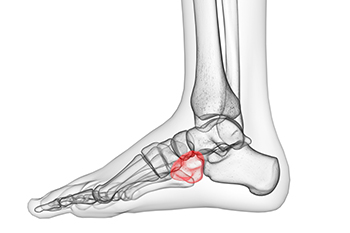Foot Injuries and Cuboid Syndrome
Tuesday, 24 October 2023 00:00
Cuboid syndrome, also known as cuboid subluxation, is a condition affecting the cuboid bone in the middle of the foot. It typically arises from foot injuries or dislocation that result in the tearing of the joints and ligaments around the cuboid bone. It is often associated with sports that stress the feet or individuals with significant overpronation. The primary symptom is foot pain and weakness, particularly when bearing weight. Swelling, tenderness, and redness may accompany these symptoms, hindering daily activities and sometimes causing a limp. Diagnosis can be challenging, as imaging tests may not consistently reveal the condition. If you have pain on the outside of the foot, it is suggested that you make an appointment with a podiatrist for a proper evaluation and tailored treatment.
Cuboid syndrome, also known as cuboid subluxation, occurs when the joints and ligaments near the cuboid bone in the foot become torn. If you have cuboid syndrome, consult with the podiatrists from New England Family Foot Care. Our doctors will assess your condition and provide you with quality foot and ankle treatment.
Cuboid syndrome is a common cause of lateral foot pain, which is pain on the outside of the foot. The condition may happen suddenly due to an ankle sprain, or it may develop slowly overtime from repetitive tension through the bone and surrounding structures.
Causes
The most common causes of cuboid syndrome include:
- Injury – The most common cause of this ailment is an ankle sprain.
- Repetitive Strain – Tension placed through the peroneus longus muscle from repetitive activities such as jumping and running may cause excessive traction on the bone causing it to sublux.
- Altered Foot Biomechanics – Most people suffering from cuboid subluxation have flat feet.
Symptoms
A common symptom of cuboid syndrome is pain along the outside of the foot which can be felt in the ankle and toes. This pain may create walking difficulties and may cause those with the condition to walk with a limp.
Diagnosis
Diagnosis of cuboid syndrome is often difficult, and it is often misdiagnosed. X-rays, MRIs and CT scans often fail to properly show the cuboid subluxation. Although there isn’t a specific test used to diagnose cuboid syndrome, your podiatrist will usually check if pain is felt while pressing firmly on the cuboid bone of your foot.
Treatment
Just as the range of causes varies widely, so do treatments. Some more common treatments are ice therapy, rest, exercise, taping, and orthotics.
If you have any questions, please feel free to contact our office located in Milton, MA . We offer the newest diagnostic and treatment technologies for all your foot care needs.




